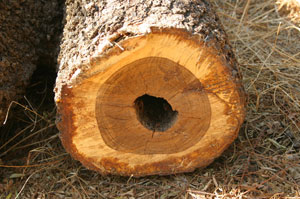 In trees, heart rot is a fungal disease that causes the decay of wood at the center of the trunk and branches. Fungi enter the tree through wounds in the bark and decay the heartwood. The diseased heartwood softens resulting in trees being structurally weaker and prone to breakage. Tree heart rot is prevalent throughout the world affecting all hardwood trees and can be very difficult to prevent. A good indication of heart rot is the presence of mushrooms or fungus conks on the tree.
In trees, heart rot is a fungal disease that causes the decay of wood at the center of the trunk and branches. Fungi enter the tree through wounds in the bark and decay the heartwood. The diseased heartwood softens resulting in trees being structurally weaker and prone to breakage. Tree heart rot is prevalent throughout the world affecting all hardwood trees and can be very difficult to prevent. A good indication of heart rot is the presence of mushrooms or fungus conks on the tree.
The prevention of tree heart rot can be a very difficult task, but there are effective measures to minimize damage. These methods include facilitating healthy growth, minimizing wounds, and proper pruning of branches. A healthy tree naturally combats tree heart rot through a process called compartmentalization. The tree grows around the decayed wood tissue and prevents the fungus from spreading to a larger area of the trunk. Providing a tree with the necessary nutrients, water, and growing conditions will promote healthy growth and minimize rot. The bark is the tree's main defense against disease; reducing the amount of large wounds and bare wood, especially in older trees, helps prevent rot.
Pruning focuses on removing dead or diseased branches with minimal damage done to the tree. Branches connect to the trunk and grow from the branch collar. While the branch itself may be dead, the branch collar is still healthy and resistant to disease. It is from the branch collar that a new limb will generate and grow, so it is important not to damage it while pruning. Improper pruning will inhibit the growth process and provide fungi with ideal growth environments. A professional tree service can properly prune your trees for you.
If you suspect that you have a tree suffering from tree heart rot or another infection, call L & A Tree Service at 903-357-9292 or contact us now for assistance.
